Numerical Study of Single-Layer and Stacked Minichannel-Based Heat Sinks Using Different Truncating Ratios for Cooling High Concentration Photovoltaic Systems
Abstract
:1. Introduction
2. Design and Methodology
2.1. Conceptual Design
2.2. Simulation Setup
2.3. Governing Equations, Boundary Conditions, and Assumptions
2.3.1. Governing Equations
2.3.2. Overall Single-Cell HCPV Module Efficiency
2.3.3. Boundary Conditions and Assumptions
- 1.
- The boundary heat source is applied to the germanium layer.
- 2.
- The top surfaces, i.e., copper layer, ceramic layer and cell top surface, are subjected to the natural convection with a constant heat transfer coefficient of (h = 15 −2 −1) and surface to ambient heat transfer radiation.
- 3.
- Thermo-physical properties of the water have temperature-dependent values.
- 4.
- The sided walls and the back plate of the MCBHS are insulated to minimize the heat losses to the surroundings.
- 5.
- The ambient and inlet water temperatures were assumed equal to 25 .
- 6.
- The range of inlet water mass flow rate in each channel is set to be between −1 and −1.
- 7.
- The water flow is assumed laminar, steady and incompressible.
- 8.
- The active cell surface area is 10 × 10 2.
- 9.
- Reynolds number range is 7–508.
- 10.
- CR is ranged between (500×–2000×).
2.3.4. Mesh Independence Study
2.3.5. Validation Study
3. Results and Discussion
3.1. Maximum Solar Cell Surface Temperature and Temperature Uniformity
3.2. Water Outlet Temperature
3.3. Electrical Efficiency
3.4. Pressure Drop
3.5. Comparative Analysis of Thermal Power to Pumping Power Ratios
4. Conclusions
- For the single-layer and stacked MCBHS, the use of a truncating ratio of 31% enables achieving minor decrease of the maximum cell temperature, compared to the conventional configurations, but that means a beneficial gain of 31% of the required materials and manufacturing cost of the mini-channel-based heat sink. This outcome has explained the higher recorded electrical efficiencies when using a truncating ratio of 31% for both the single-layer and stacked MCBHS. However, for all investigated configurations, a truncating ratio of 65% is more effective to ensure more surface temperature uniformity distribution.
- For both single-layer and stacked MCBHS, a truncating ratio of 65% qualifies the recording of the highest water outlet temperature and the lowest pressure drops relatively compared to the conventional MCBHS configurations. The highest water temperature has reached up to 52.7 by the stacked MCBHS with a truncating ratio of 65% and reached under CR of 2000× and a mass flow rate of 0.001 kg/s.
- For both single-layer and stacked MCBHS, the use of a truncating ratio of 65% has driven the upper hands to achieve higher ratio of thermal power to pumping power. The maximum RTP values have been recorded by the single-layer MCBHS with a truncating ratio of 65% equal to 23.61 × and 233.06 × at a mass flow rate of −1 and −1, respectively, under 2000×. Here, it is worth noticing that at high water flow rates, this superiority being achieved by using a truncating ratio of 65% becomes insignificant.
5. Future Work
Author Contributions
Funding
Data Availability Statement
Acknowledgments
Conflicts of Interest
Nomenclature
| Abbreviations | |
| HCPV | High concentration photovoltaic |
| DNI | Direct normal irradiance |
| CR | Concentration ratio |
| MJSC | Multi-junction solar cell |
| MCBHS | Mini channel-based heat sink |
| Re | Reynold’s number |
| Symbols | |
| Area of the solar cell [2] | |
| Q | Thermal power [] |
| E | Electric power [] |
| Volume flow rate [−1] | |
| P | Pressure [] |
| T | Temperature [] |
| u | Velocity vector [−1] |
| Specific heat capacity [−1] | |
| Thermal flux via conduction [−2] | |
| Thermal flux via radiation [−2] | |
| Body force vector [] | |
| Greek symbols | |
| Electrical efficiency of the solar cell | |
| Viscous stress tensor | |
| Optical efficiency of the solar cell | |
| Thermal expansion coefficient | |
| Density [] | |
| Subscripts | |
| Fluid outlet | |
| Fluid inlet |
References
- AlOtaibi, Z.S.; Khonkar, H.I.; AlAmoudi, A.O.; Alqahtani, S.H. Current status and future perspectives for localizing the solar photovoltaic industry in the Kingdom of Saudi Arabia. Energy Transit. 2020, 4, 1–9. [Google Scholar] [CrossRef] [Green Version]
- McCrone, A.; Moslener, U.; Destais, F.; Usher, E.; Grüning, C. Global Trends in Renewable Energy Investment 2016; Technical Report, Frankfurt School-UNEP Centre and Bloomberg New Energy Finance Report; Frankfurt School of Finance and Management: Frankfurt am Main, Germany, 2016. [Google Scholar]
- Maatallah, T.S. A comprehensive study of pin fins cooling channel for a single-cell concentration photovoltaic system under ultra-high concentration ratios. Int. J. Energy Res. 2020, 45, 4613–4629. [Google Scholar] [CrossRef]
- Aldossary, A.; Mahmoud, S.; Al-Dadah, R. Technical feasibility study of passive and active cooling for concentrator PV in harsh environment. Appl. Therm. Eng. 2016, 100, 490–500. [Google Scholar] [CrossRef]
- Khouya, A. Levelized costs of energy and hydrogen of wind farms and concentrated photovoltaic thermal systems. A case study in Morocco. Int. J. Hydrogen Energy 2020, 45, 31632–31650. [Google Scholar] [CrossRef]
- Khouya, A. Performance analysis and optimization of a trilateral organic Rankine powered by a concentrated photovoltaic thermal system. Energy 2022, 247, 123439. [Google Scholar] [CrossRef]
- Jakhar, S.; Soni, M.S.; Gakkhar, N. Historical and recent development of concentrating photovoltaic cooling technologies. Renew. Sustain. Energy Rev. 2016, 60, 41–59. [Google Scholar] [CrossRef]
- Gilmore, N.; Timchenko, V.; Menictas, C. Microchannel cooling of concentrator photovoltaics: A review. Renew. Sustain. Energy Rev. 2018, 90, 1041–1059. [Google Scholar] [CrossRef]
- Xiao, M.; Tang, L.; Zhang, X.; Lun, I.Y.F.; Yuan, Y. A review on recent development of cooling technologies for concentrated photovoltaics (CPV) systems. Energies 2018, 11, 3416. [Google Scholar] [CrossRef] [Green Version]
- Shittu, S.; Li, G.; Zhao, X.; Akhlaghi, Y.G.; Ma, X.; Yu, M. Comparative study of a concentrated photovoltaic-thermoelectric system with and without flat plate heat pipe. Energy Convers. Manag. 2019, 193, 1–14. [Google Scholar] [CrossRef]
- Alzahrani, M.; Baig, H.; Shanks, K.; Mallick, T. Estimation of the performance limits of a concentrator solar cell coupled with a micro heat sink based on a finite element simulation. Appl. Therm. Eng. 2020, 176, 115315. [Google Scholar] [CrossRef]
- Anand, S.; Senthil Kumar, M.; Balasubramanian, K.R.; Krishnan, R.A.; Maheswari, L. An experimental study on thermal management of concentrated photovoltaic cell using loop heat pipe and heat sink. Heat Transf. Asian Res. 2019, 48, 2456–2477. [Google Scholar] [CrossRef]
- Ahmed, A.; Shanks, K.; Sundaram, S.; Mallick, T.K. Theoretical investigation of the temperature limits of an actively cooled high concentration photovoltaic system. Energies 2020, 13, 1902. [Google Scholar] [CrossRef] [Green Version]
- Ahmed, A.; Zhang, G.; Shanks, K.; Sundaram, S.; Ding, Y.; Mallick, T. Performance evaluation of single multi-junction solar cell for high concentrator photovoltaics using minichannel heat sink with nanofluids. Appl. Therm. Eng. 2021, 182, 115868. [Google Scholar] [CrossRef]
- Rastan, H.; Abdi, A.; Hamawandi, B.; Ignatowicz, M.; Meyer, J.P.; Palm, B. Heat transfer study of enhanced additively manufactured minichannel heat exchangers. Int. J. Heat Mass Transf. 2020, 161, 120271. [Google Scholar] [CrossRef]
- Deng, Z.; Shen, J.; Dai, W.; Liu, Y.; Song, Q.; Gong, W.; Ke, L.; Gong, M. Flow and thermal analysis of hybrid mini-channel and slot jet array heat sink. Appl. Therm. Eng. 2020, 171, 115063. [Google Scholar] [CrossRef]
- Xiao, H.; Liu, Z.; Liu, W. Conjugate heat transfer enhancement in the mini-channel heat sink by realizing the optimized flow pattern. Appl. Therm. Eng. 2021, 182, 116131. [Google Scholar] [CrossRef]
- Anwar, M.; Tariq, H.A.; Shoukat, A.A.; Ali, H.M.; Ali, H. Numerical study for heat transfer enhancement using cuo-water nanofluids through mini-channel heat sinks for microprocessor cooling. Therm. Sci. 2020, 24, 2965–2976. [Google Scholar] [CrossRef] [Green Version]
- Barrau, J.; Chemisana, D.; Rosell, J.; Tadrist, L.; Ibañez, M. An experimental study of a new hybrid jet impingement/micro-channel cooling scheme. Appl. Therm. Eng. 2010, 30, 2058–2066. [Google Scholar] [CrossRef] [Green Version]
- Ali, A.; Abo-Zahhad, E.M.; Elqady, H.I.; Rabie, M.; Elkady, M.F.; El-Shazly, A.H. Impact of microchannel heat sink configuration on the performance of high concentrator photovoltaic solar module. Energy Rep. 2020, 6, 260–265. [Google Scholar] [CrossRef]
- Ali, A.Y.M.; Abo-Zahhad, E.M.; Elqady, H.I.; Rabie, M.; Elkady, M.F.; Ookawara, S.; El-Shazly, A.H.; Radwan, A. Thermal analysis of high concentrator photovoltaic module using convergent-divergent microchannel heat sink design. Appl. Therm. Eng. 2021, 183, 116201. [Google Scholar] [CrossRef]
- Khoshvaght-Aliabadi, M.; Hormozi, F.; Zamzamian, A. Experimental analysis of thermal-hydraulic performance of copper-water nanofluid flow in different plate-fin channels. Exp. Therm. Fluid Sci. 2014, 52, 248–258. [Google Scholar] [CrossRef]
- Abo-Zahhad, E.M.; Ookawara, S.; Radwan, A.; El-Shazly, A.H.; ElKady, M.F. Thermal and structure analyses of high concentrator solar cell under confined jet impingement cooling. Energy Convers. Manag. 2018, 176, 39–54. [Google Scholar] [CrossRef]
- Abo-Zahhad, E.M.; Ookawara, S.; Radwan, A.; El-Shazly, A.H.; Elkady, M.F. Numerical analyses of hybrid jet impingement/microchannel cooling device for thermal management of high concentrator triple-junction solar cell. Appl. Energy 2019, 253, 113538. [Google Scholar] [CrossRef]
- Abo-Zahhad, E.M.; Ookawara, S.; Esmail, M.F.; El-Shazly, A.H.; Elkady, M.F.; Radwan, A. Thermal management of high concentrator solar cell using new designs of stepwise varying width microchannel cooling scheme. Appl. Therm. Eng. 2020, 172, 115124. [Google Scholar] [CrossRef]
- Sabry, M. Temperature optimization of high concentrated active cooled solar cells. NRIAG J. Astron. Geophys. 2016, 5, 23–29. [Google Scholar] [CrossRef] [Green Version]
- Tan, W.C.; Chong, K.K.; Tan, M.H. Performance study of water-cooled multiple-channel heat sinks in the application of ultra-high concentrator photovoltaic system. Sol. Energy 2017, 147, 314–327. [Google Scholar] [CrossRef]
- Bird, R.B.; Stewart, W.E.; Lightfoot, E.N. Transport Phenomena, 2nd ed.; John Wiley & Sons, Inc.: Hoboken, NJ, USA, 2002. [Google Scholar]
- Burmeister, C.L. Convective Heat Transfer, 2nd ed.; John Wiley & Sons Inc.: Hoboken, NJ, USA, 1993. [Google Scholar]
- AlFalah, G.; Maatallah, T.S.; Alzahrani, M.; Al-Amri, F.G. Optimization and feasibility analysis of a microscale pin-fins heat sink of an ultrahigh concentrating photovoltaic system. Int. J. Energy Res. 2020, 44, 11852–11871. [Google Scholar] [CrossRef]
- Ahmed, F.E.; Lalia, B.S.; Hashaikeh, R.; Hilal, N. Alternative heating techniques in membrane distillation: A review. Desalination 2020, 496, 114713. [Google Scholar] [CrossRef]
- Li, Q.; Beier, L.J.; Tan, J.; Brown, C.; Lian, B.; Zhong, W.; Wang, Y.; Ji, C.; Dai, P.; Li, T.; et al. An integrated, solar-driven membrane distillation system for water purification and energy generation. Appl. Energy 2019, 237, 534–548. [Google Scholar] [CrossRef]
- Sharif, M.K.A.; Al-Abidi, A.A.; Mat, S.; Sopian, K.; Ruslan, M.H.; Sulaiman, M.Y.; Rosli, M.A.M. Review of the application of phase change material for heating and domestic hot water systems. Renew. Sustain. Energy Rev. 2015, 42, 557–568. [Google Scholar] [CrossRef]
- Nikbakhti, R.; Wang, X.; Chan, A. Performance analysis of an integrated adsorption and absorption refrigeration system. Int. J. Refrig. 2020, 117, 269–283. [Google Scholar] [CrossRef]
- Kharchenko, V.; Panchenko, V.; Tikhonov, P.V.; Vasant, P. Cogenerative PV thermal modules of different design for autonomous heat and electricity supply. In Handbook of Research on Renewable Energy and Electric Resources for Sustainable Rural Development; IGI Global: Hershey, PA, USA, 2018; pp. 86–119. [Google Scholar]
- Panchenko, V.; Izmailov, A.; Kharchenko, V.; Lobachevskiy, Y. Photovoltaic Solar Modules of Different Types and Designs for Energy Supply. Int. J. Energy Optim. Eng. 2020, 9, 74–94. [Google Scholar] [CrossRef]
- Panchenko, V. Photovoltaic Thermal Module With Paraboloid Type Solar Concentrators. Int. J. Energy Optim. Eng. 2021, 10, 1–23. [Google Scholar] [CrossRef]
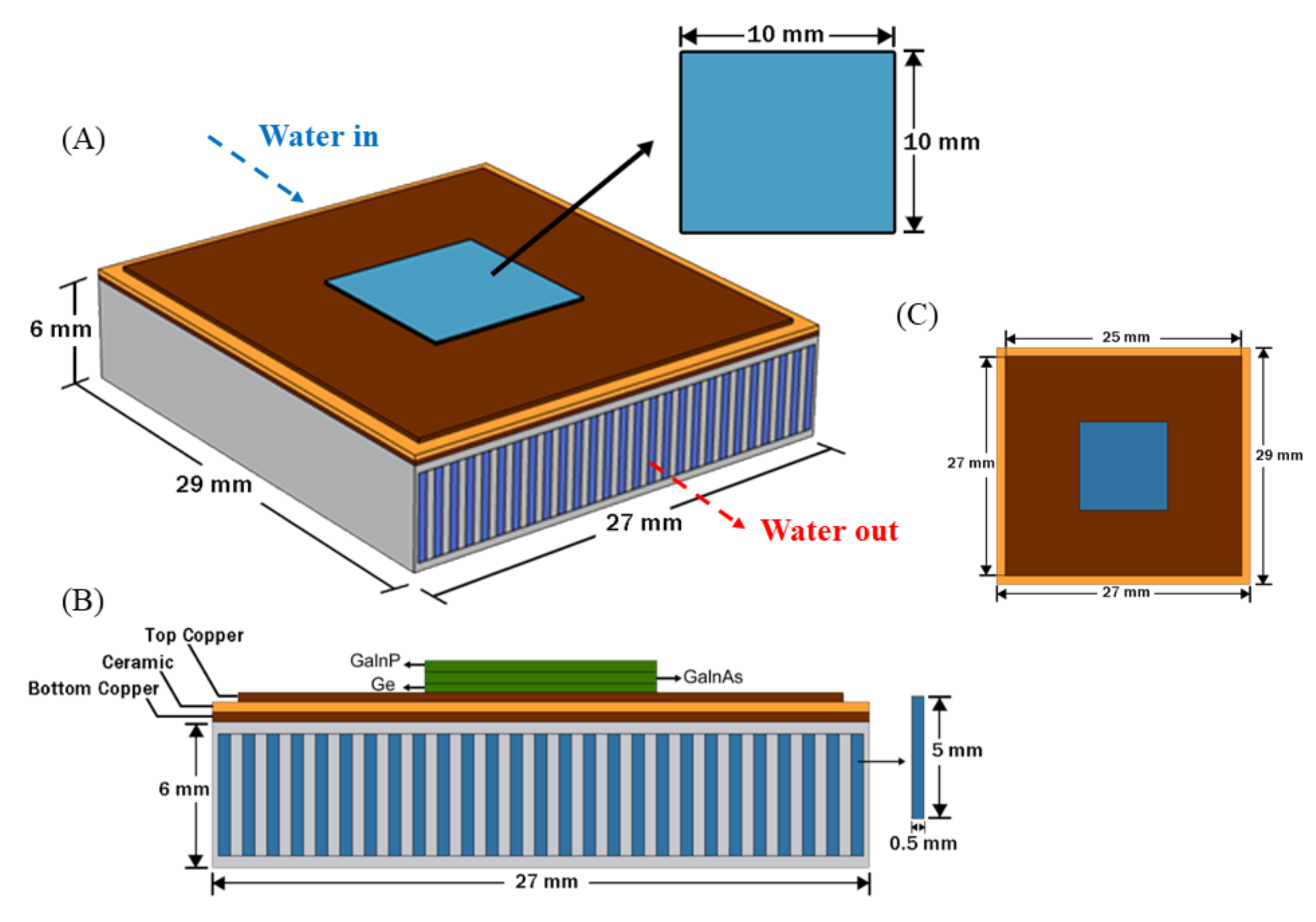
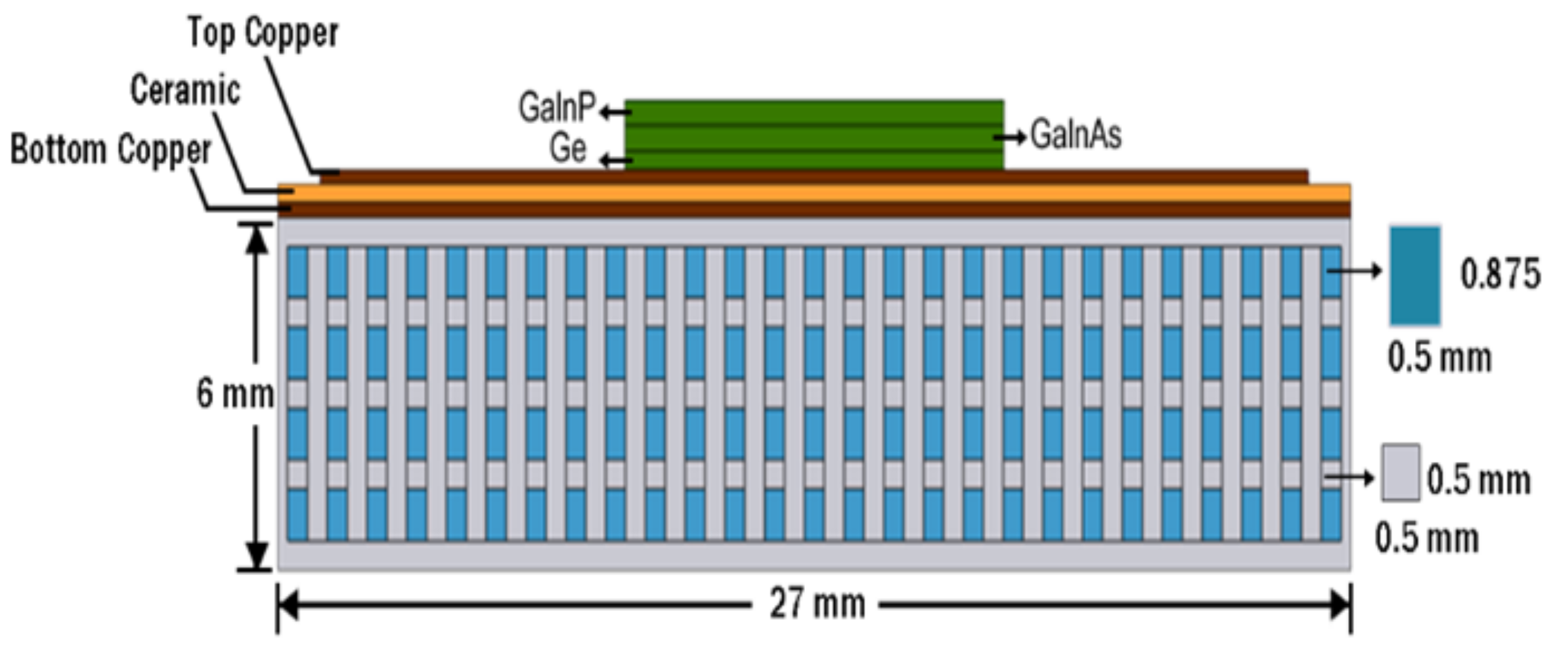
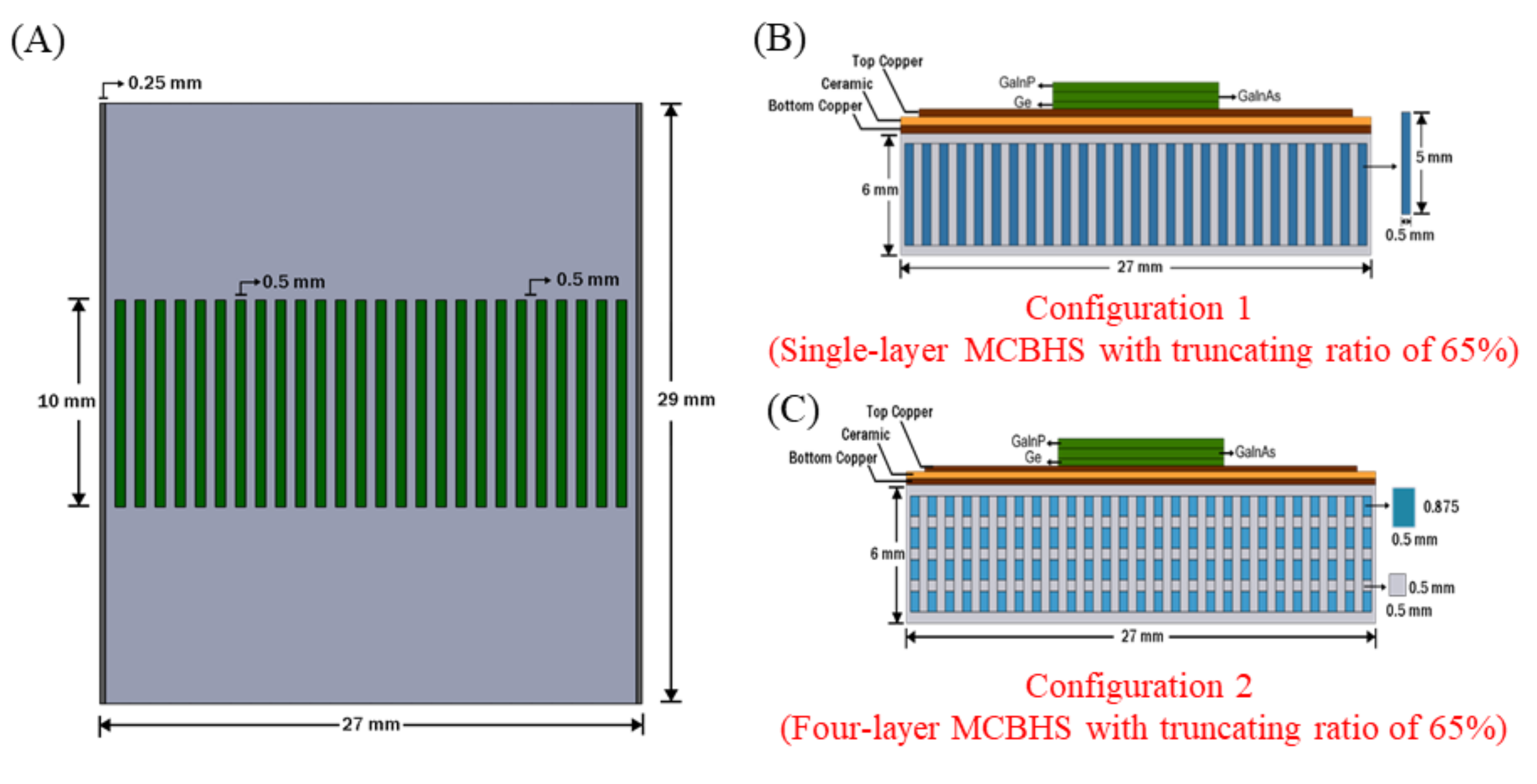
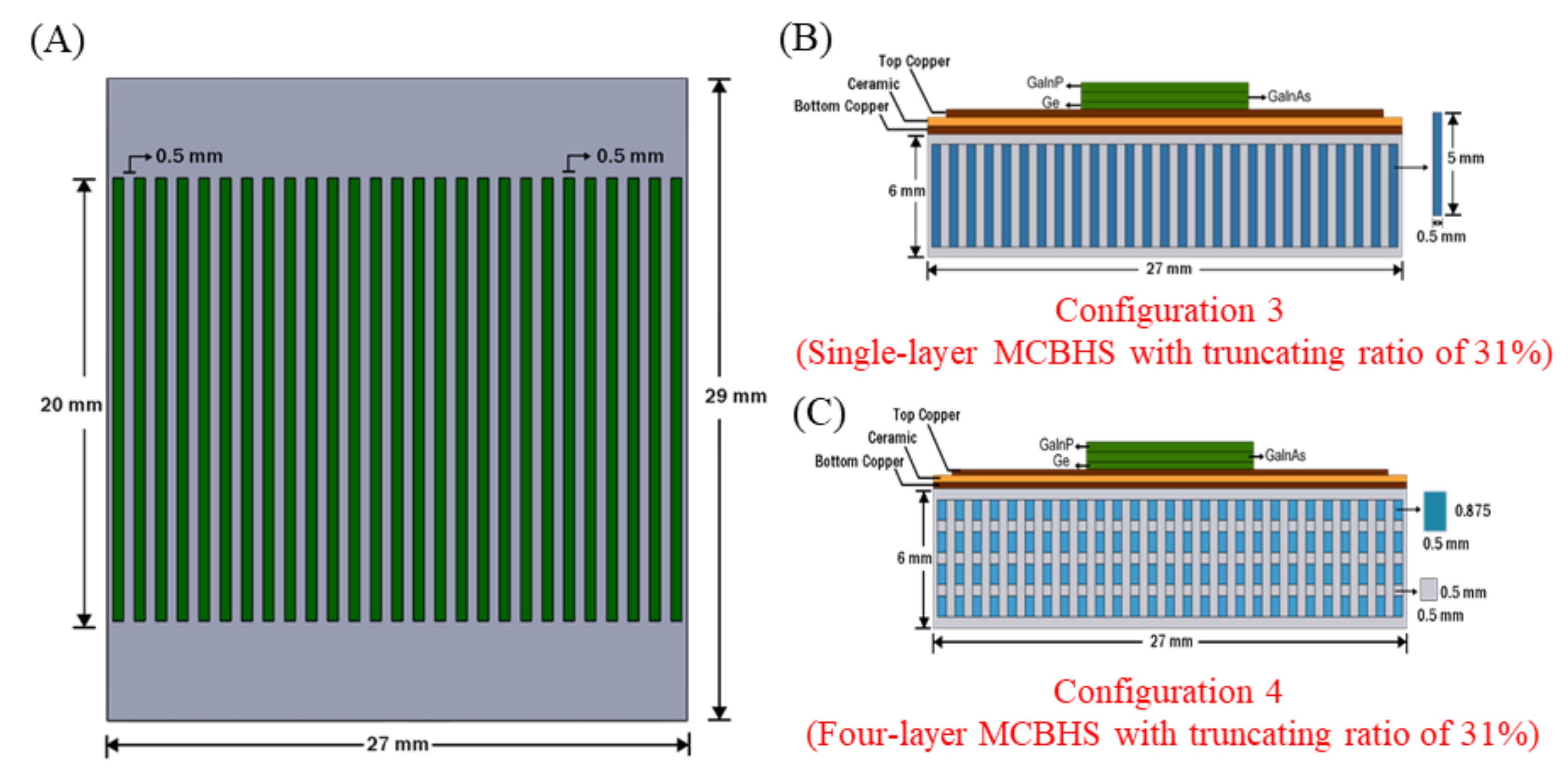
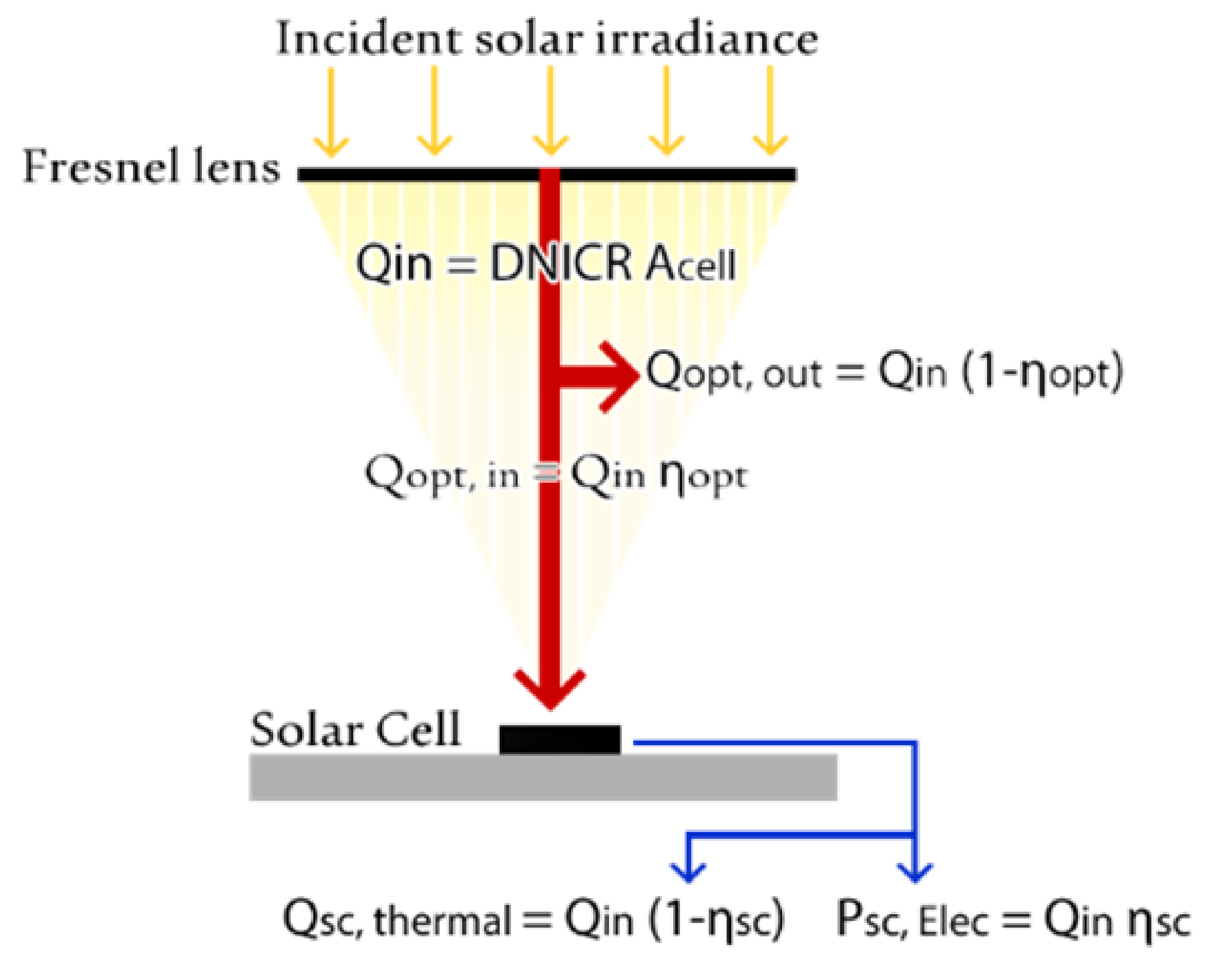

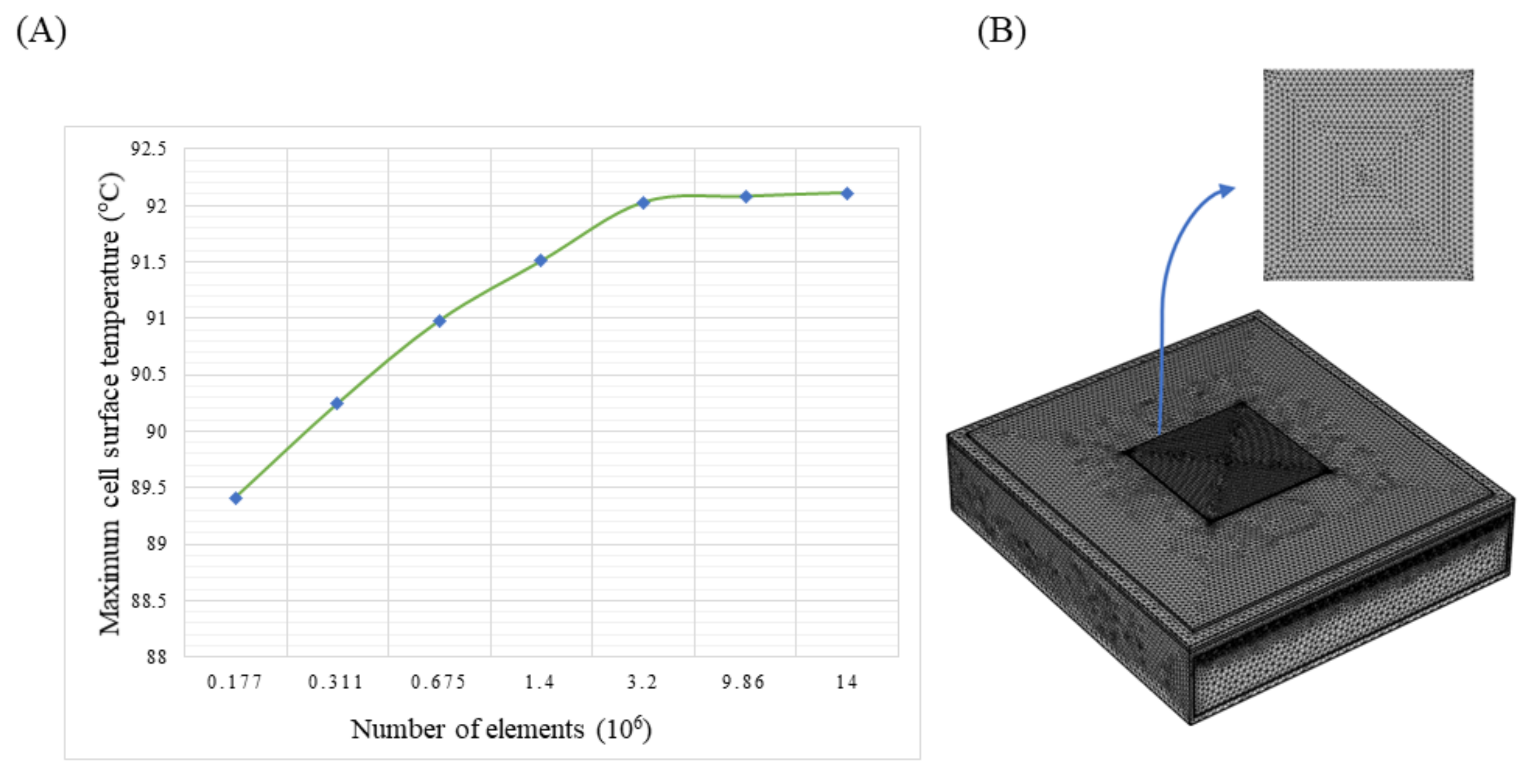
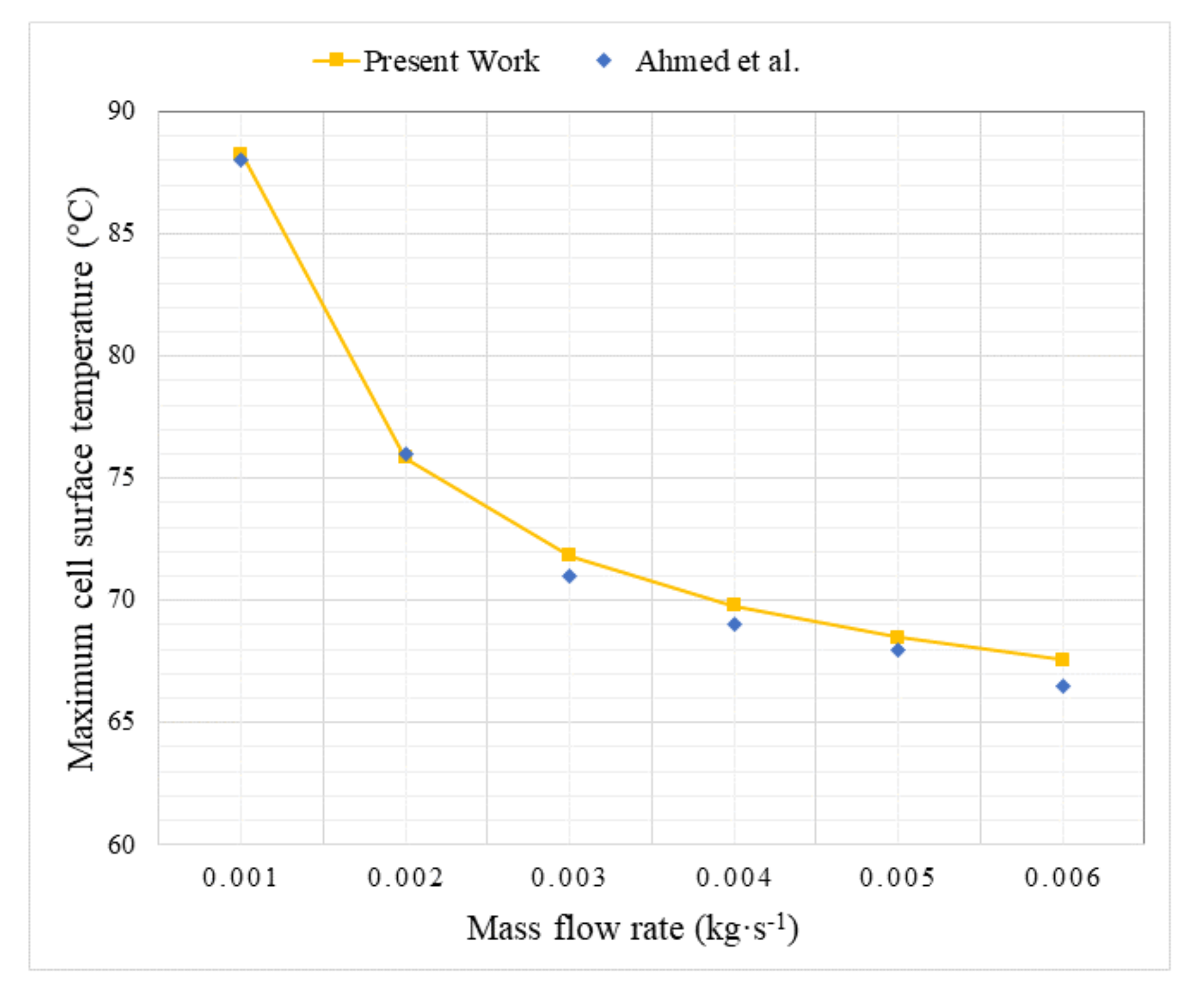
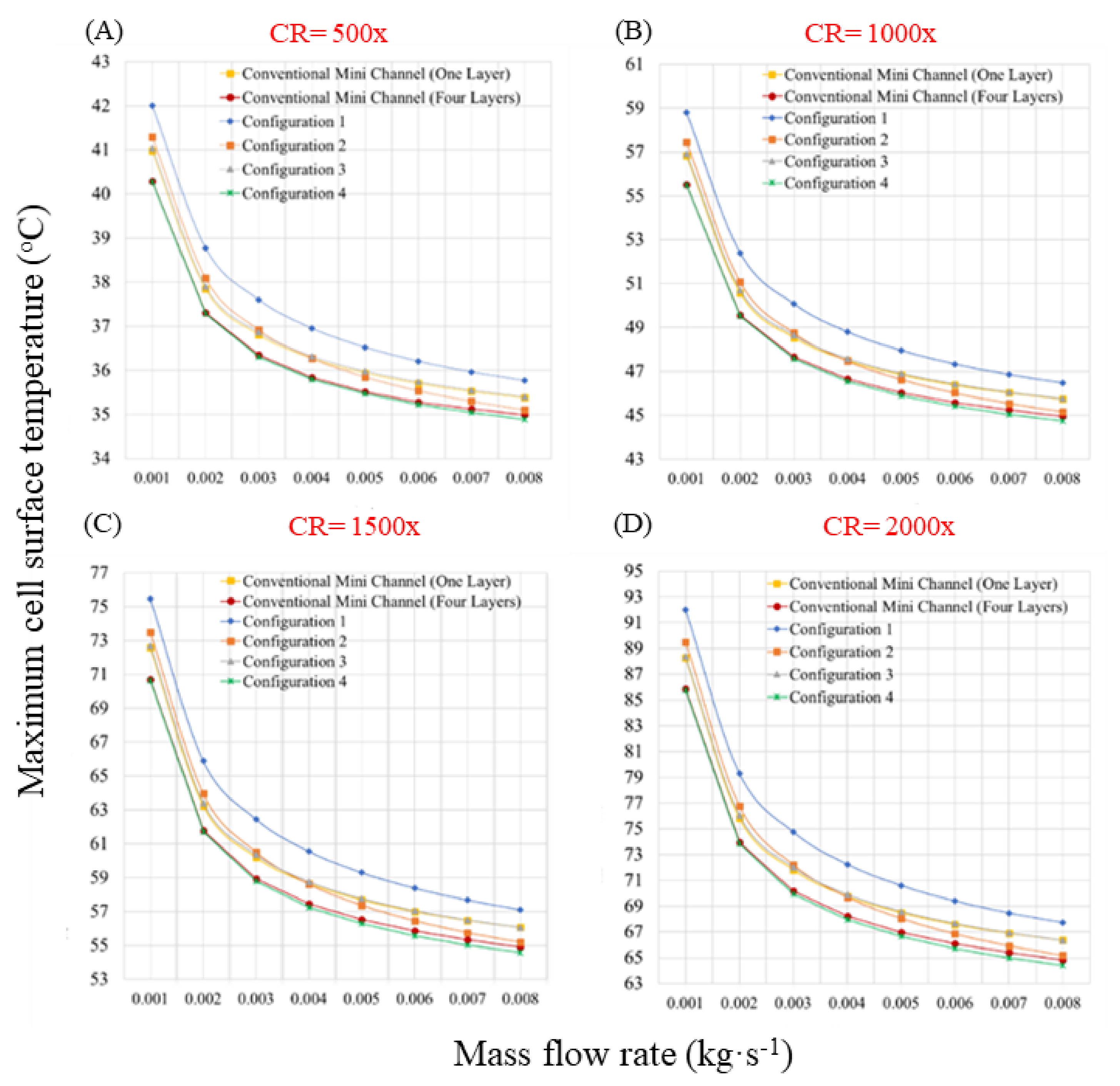
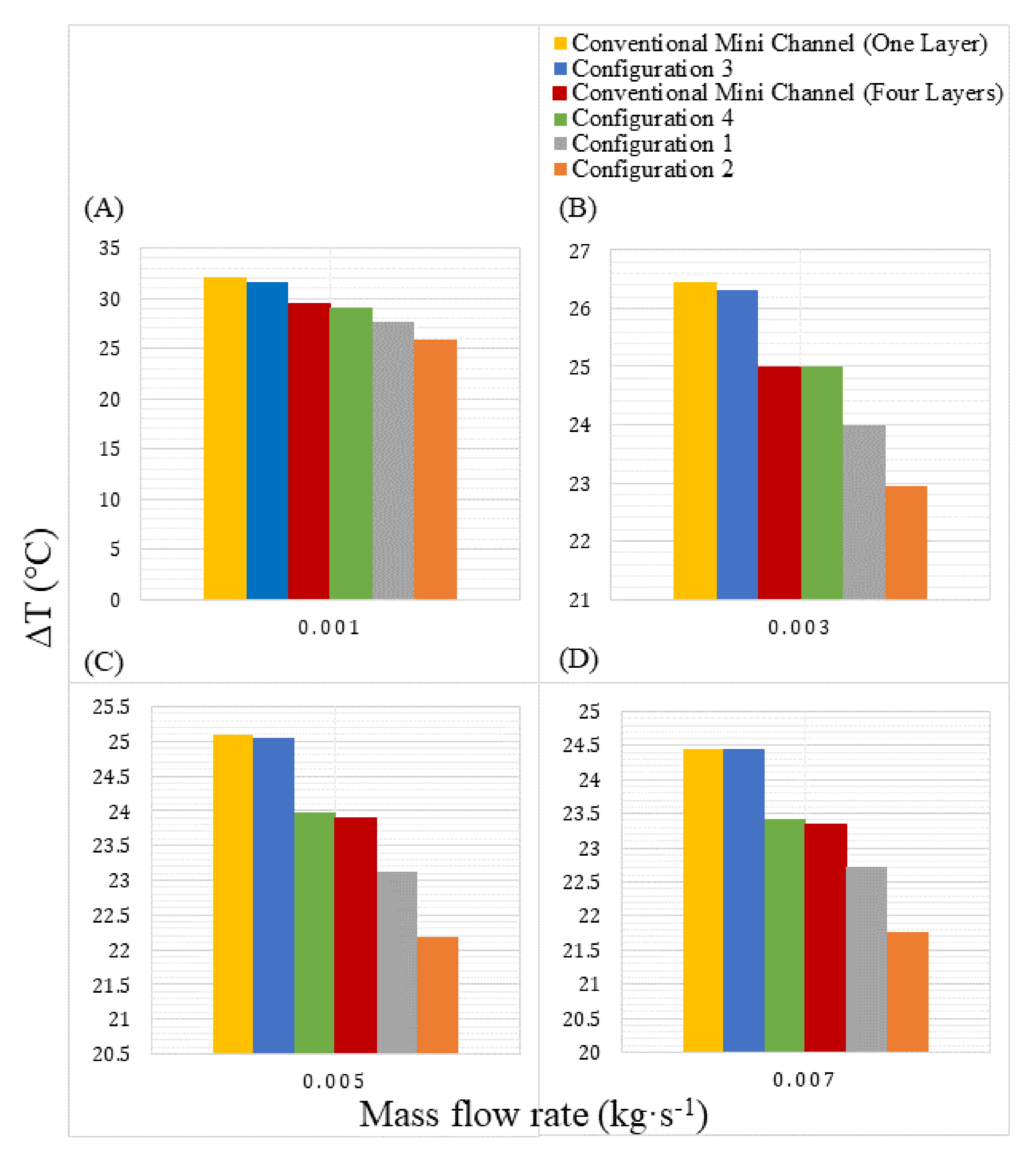
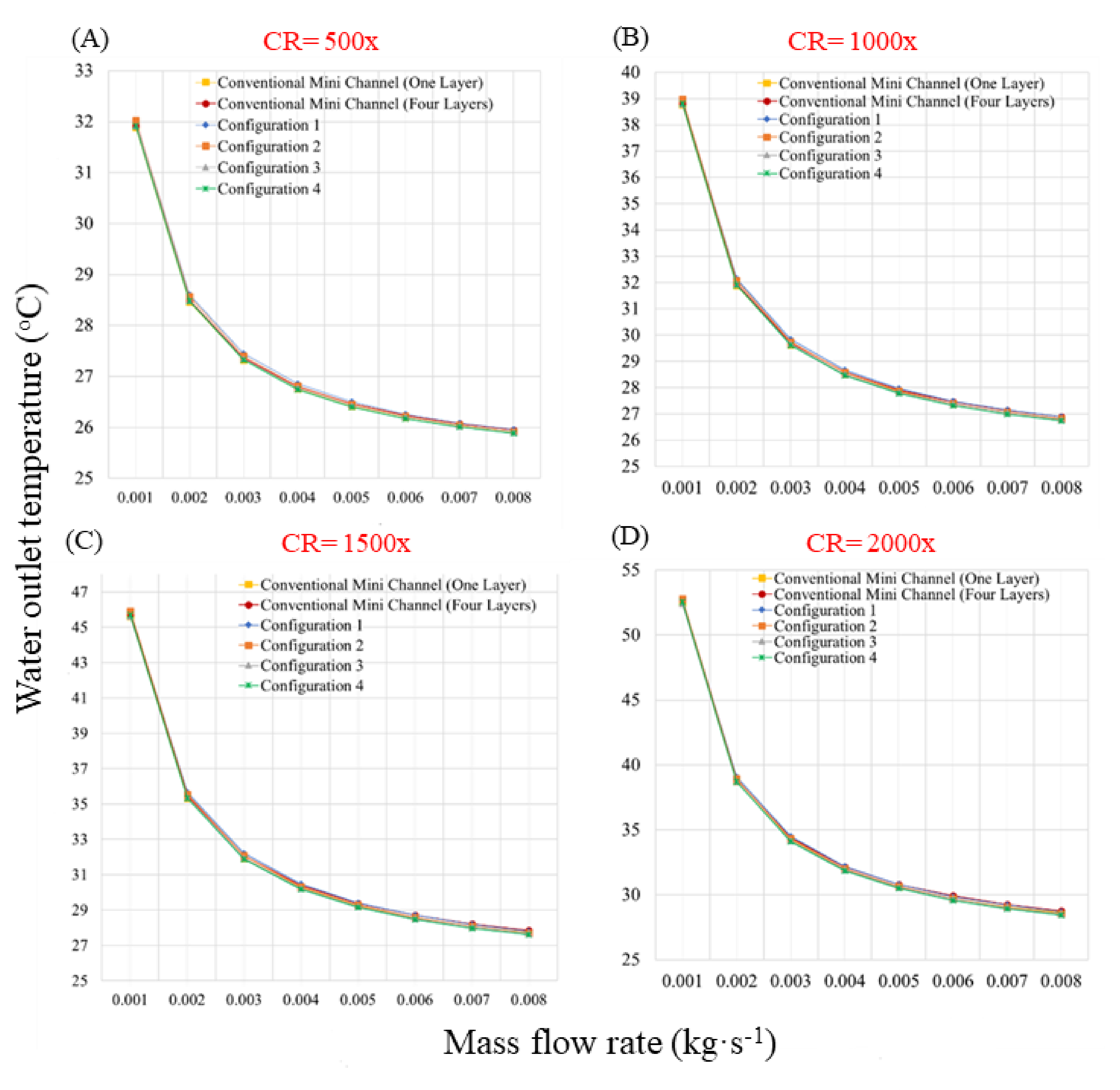
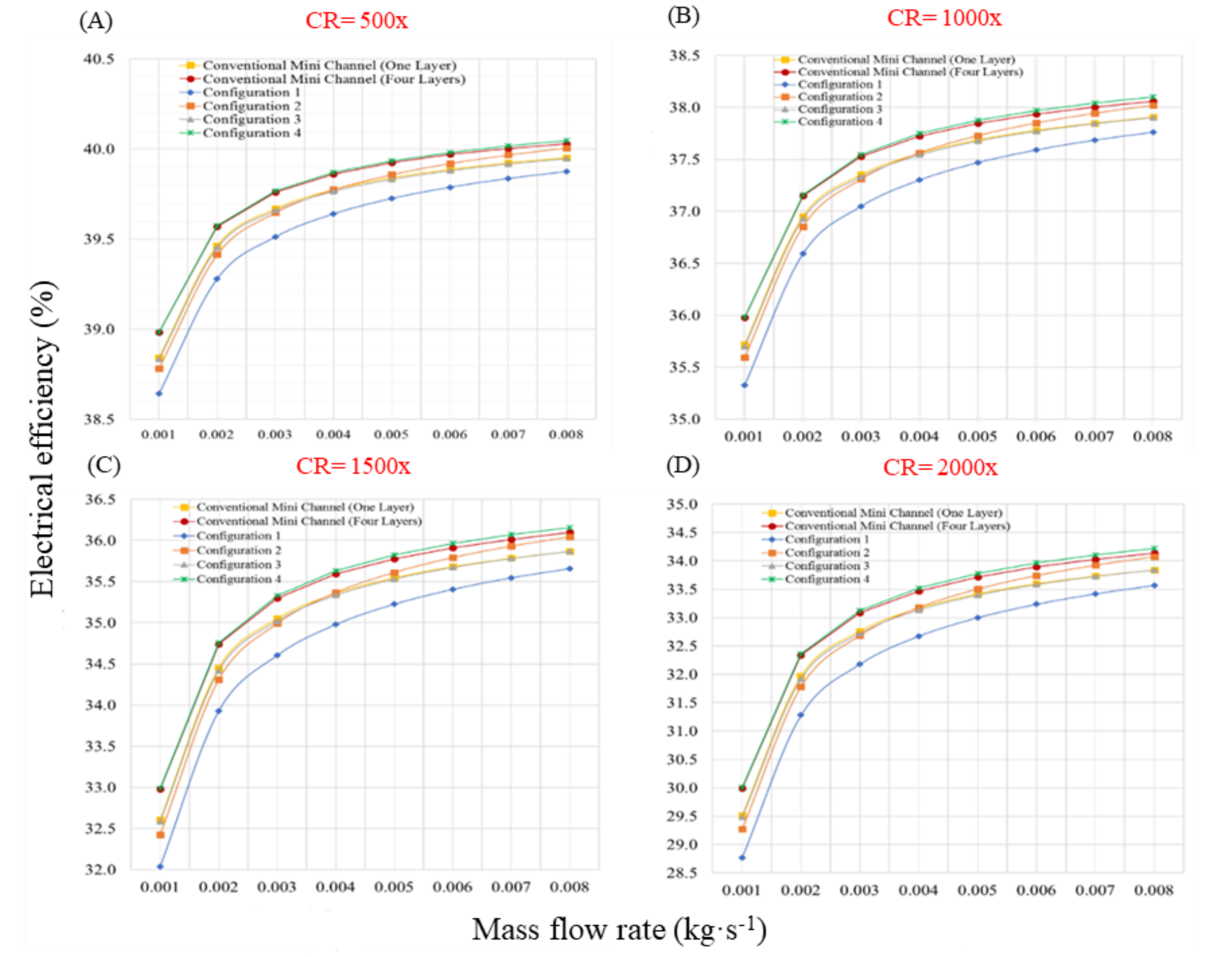
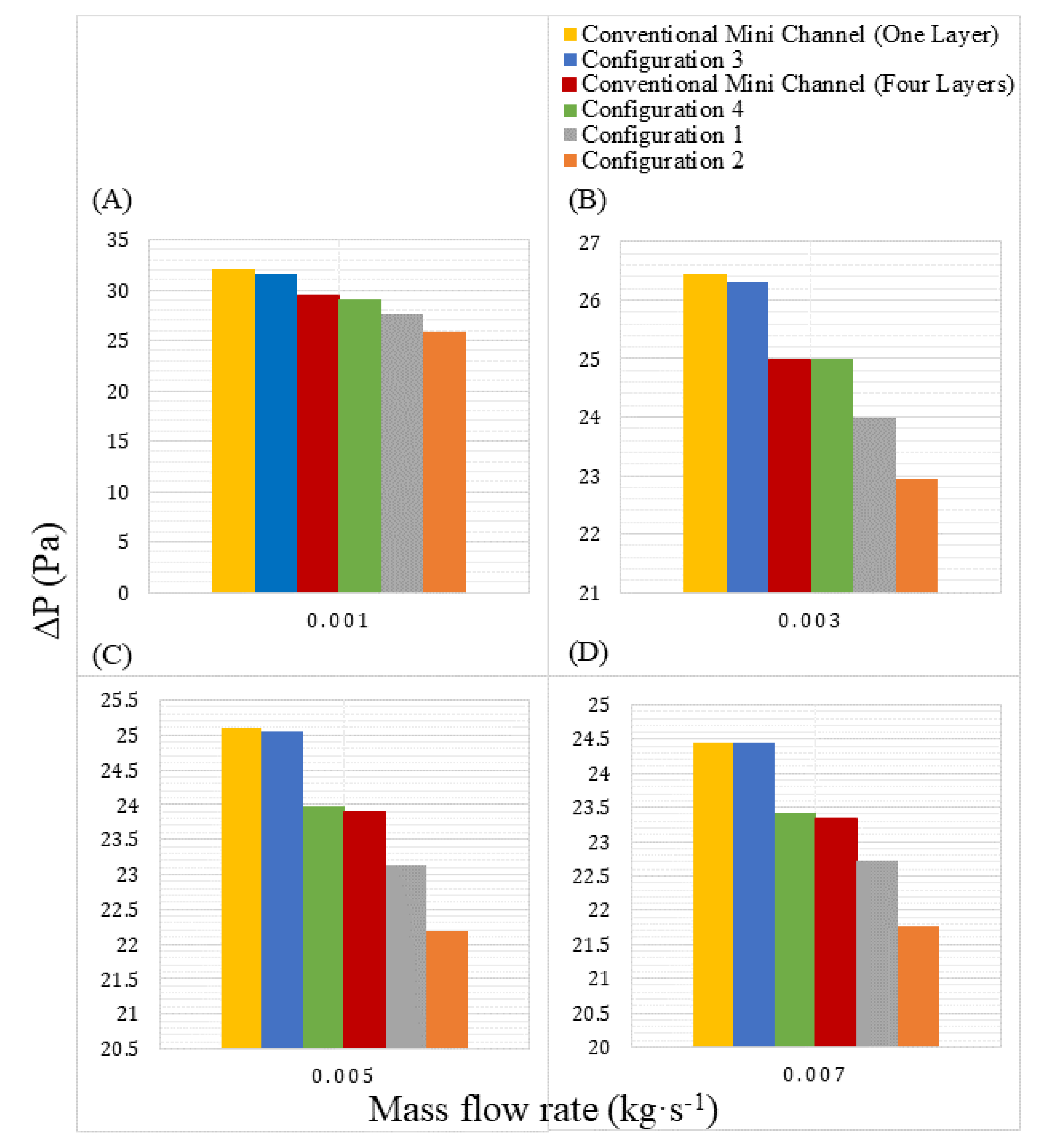
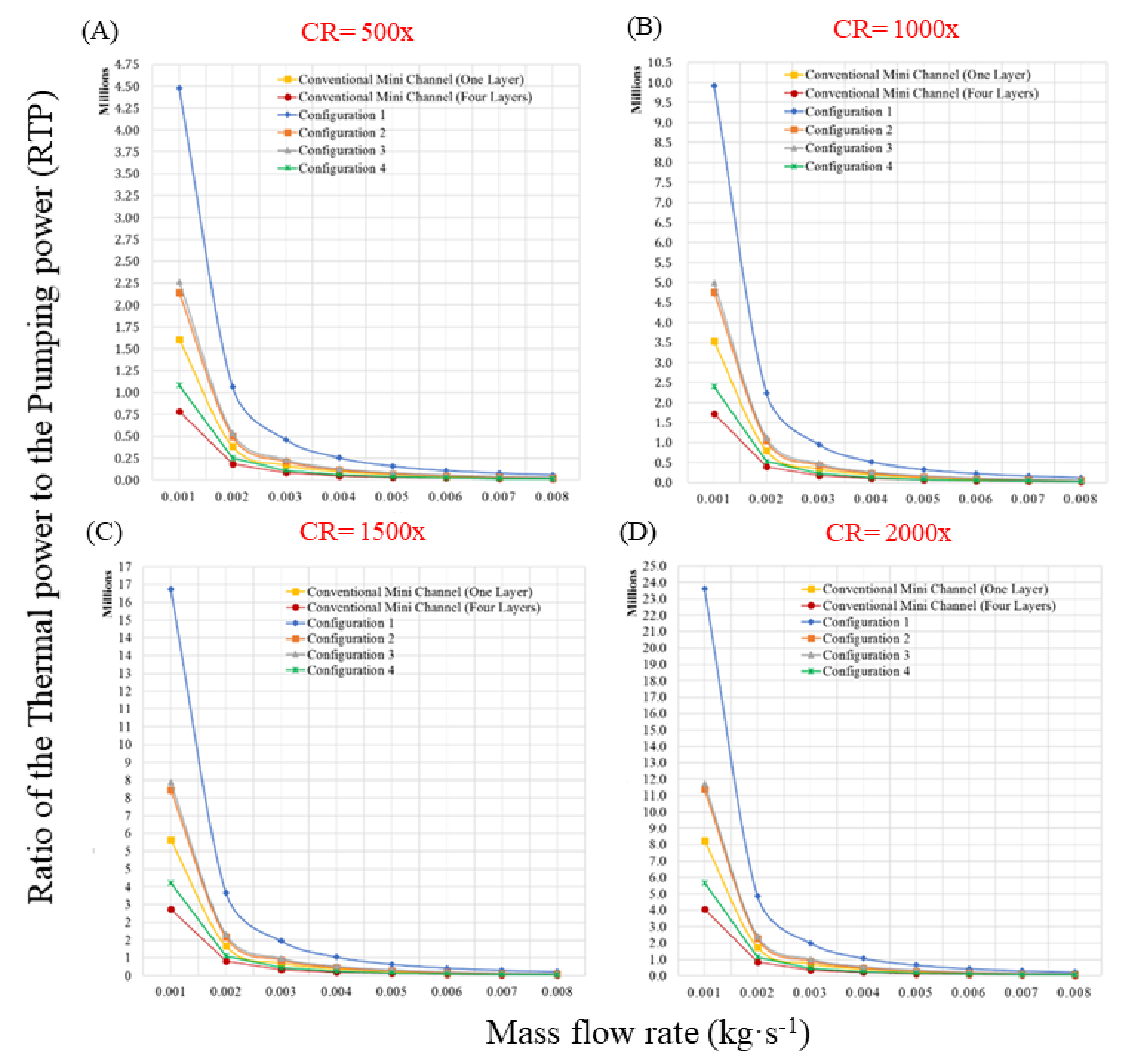
| Material | Length (mm) | Width (mm) | Thickness (mm) |
|---|---|---|---|
| Aluminum | 29 | 27 | 6 |
| GalnP | 10 | 10 | 0.07 |
| GalnAs | 10 | 10 | 0.07 |
| Ge | 10 | 10 | 0.07 |
| Copper (1) | 27 | 25 | 0.25 |
| Ceramic | 29 | 27 | 0.32 |
| Copper (2) | 29 | 27 | 0.25 |
| Material | Thermal Conductivity, k (W m K) | Specific Heat Capacity, C (J kg K) | Density, (kg m) | Emissivity, |
|---|---|---|---|---|
| Aluminum | 160 | 900 | 2700 | - |
| GalnP | 73 | 370 | 4470 | 0.9 |
| GalnAs | 65 | 550 | 5316 | - |
| Ge | 60 | 320 | 5323 | - |
| Copper | 400 | 385 | 8700 | 0.05 |
| Ceramic | 27 | 900 | 3900 | 0.75 |
Publisher’s Note: MDPI stays neutral with regard to jurisdictional claims in published maps and institutional affiliations. |
© 2022 by the authors. Licensee MDPI, Basel, Switzerland. This article is an open access article distributed under the terms and conditions of the Creative Commons Attribution (CC BY) license (https://creativecommons.org/licenses/by/4.0/).
Share and Cite
Okasha, A.T.; Al-Amri, F.G.; Maatallah, T.; Hassanain, N.A.M.; Alghamdi, A.K.; Zachariah, R. Numerical Study of Single-Layer and Stacked Minichannel-Based Heat Sinks Using Different Truncating Ratios for Cooling High Concentration Photovoltaic Systems. Sustainability 2022, 14, 5352. https://doi.org/10.3390/su14095352
Okasha AT, Al-Amri FG, Maatallah T, Hassanain NAM, Alghamdi AK, Zachariah R. Numerical Study of Single-Layer and Stacked Minichannel-Based Heat Sinks Using Different Truncating Ratios for Cooling High Concentration Photovoltaic Systems. Sustainability. 2022; 14(9):5352. https://doi.org/10.3390/su14095352
Chicago/Turabian StyleOkasha, Ahmed T., Fahad Ghallab Al-Amri, Taher Maatallah, Nagmeldeen A. M. Hassanain, Abdullah Khalid Alghamdi, and Richu Zachariah. 2022. "Numerical Study of Single-Layer and Stacked Minichannel-Based Heat Sinks Using Different Truncating Ratios for Cooling High Concentration Photovoltaic Systems" Sustainability 14, no. 9: 5352. https://doi.org/10.3390/su14095352
APA StyleOkasha, A. T., Al-Amri, F. G., Maatallah, T., Hassanain, N. A. M., Alghamdi, A. K., & Zachariah, R. (2022). Numerical Study of Single-Layer and Stacked Minichannel-Based Heat Sinks Using Different Truncating Ratios for Cooling High Concentration Photovoltaic Systems. Sustainability, 14(9), 5352. https://doi.org/10.3390/su14095352






